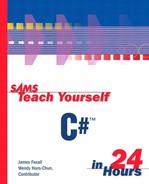Answers to Hour 17
| 1: | To create objects, you must first create a template. This template is called a: |
| A1: | Class |
| 2: | One of the primary benefits of object-oriented programming is that objects contain both their data and their code. This is called: |
| A2: | Encapsulation |
| 3: | With static classes, public variables and routines are always available to code via the static class in other modules. Is this true with public variables and routines in classes? |
| A3: | No. To access the public variables and routines, an object must be instantiated from the class. |
| 4: | True or False: Each object derived from a class has its own set of class-level data. |
| A4: | True |
| 5: | What must you do to create a property that can be read but not changed by client code? |
| A5: | Create a property procedure that includes the get accessor, but not the set accessor. |
| 6: | What is the best way to store the internal value of a property within a class? |
| A6: | As a private class-level variable |
| 7: | Which is generally superior, early binding or late binding? |
| A7: | Early binding |
| 8: | What is the best way to release an object you no longer need? |
| A8: | Call the object's Dispose() method if it has one, and then set the object variable to null. |
..................Content has been hidden....................
You can't read the all page of ebook, please click here login for view all page.
